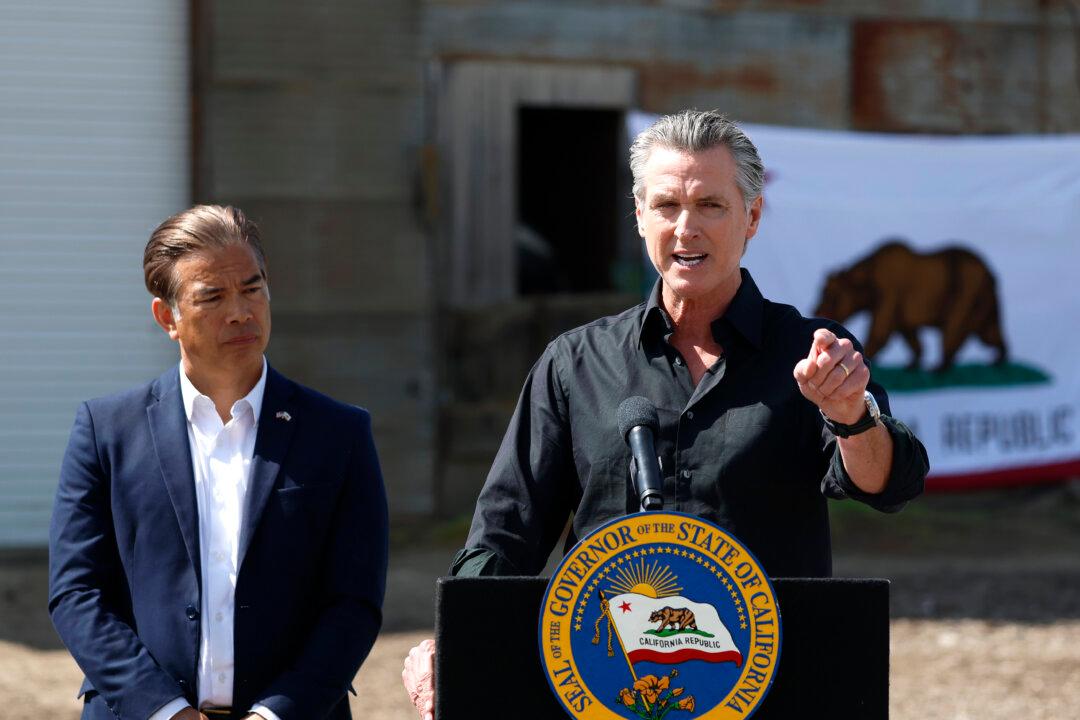After the Supreme Court issued a ruling in June that allows local governments to enforce laws related to illegal camping and homelessness, California Gov. Gavin Newsom issued an executive order on July 25 directing state departments and agencies to start clearing encampments.
“This executive order directs state agencies to move urgently to address dangerous encampments while supporting and assisting the individuals living in them—and provides guidance for cities and counties to do the same,” Mr. Newsom said in a statement accompanying the order.
Although he cannot force local governments to act in their jurisdictions, he urged officials to adopt policies that allow for the removal of homeless camps to help protect public safety.
“There are simply no more excuses,” Mr. Newsom said. “It’s time for everyone to do their part.”
The executive order noted the effect of legal action and injunctions that have prevented local officials from removing encampments in the past, thus “leaving officials without the tools or guidance necessary to address the crisis on their streets.”
The Ninth U.S. Circuit Court of Appeals decision in a case known as Grants Pass issued in September 2022 blocked local governments from clearing encampments and enforcing their laws, with justices declaring that such action would be “cruel and unusual punishment” if sufficient shelter space were not available.
But the high court’s 6–3 ruling on June 28 overturned the decision.
“Though doubtless well intended ... answers to questions such as what constitutes ‘involuntarily’ homelessness or when a shelter is ‘practically available’ cannot be found in the cruel and unusual punishments clause [of the U.S. Constitution],” Supreme Court Justice Neil Gorsuch wrote in the majority opinion. “Nor do federal judges enjoy any special competence to provide them.”
With the legal obstacles now removed, the governor is ordering agencies and departments under his authority to immediately begin clearing encampments from state property.
Officials are instructed to follow guidelines in the California Department of Transportation’s Maintenance Policy Directive, working in partnership with local agencies while prioritizing removing encampments.
Site assessments will determine whether encampments pose imminent threats—including those to “life, health, safety, or infrastructure”—and if any are found, the encampments are to be immediately cleared.
At encampments where no such threats are identified, officials are ordered to post a notice to vacate at least 48 hours before sweeps begin.
Outreach services for those living at the camps will be provided.

Officials will collect, label, and store personal items cleared from the encampments for at least 60 days.
Departments and agencies not under the governor’s direct authority are asked to follow similar guidelines.
Similarly, local governments are “encouraged” to adopt policies and take advantage of available resources and infrastructure “to take action with the urgency this crisis demands to humanely remove encampments from public spaces,” the executive order states.
San Francisco recently announced that leaders are crafting new guidelines to remove encampments, but other cities such as Los Angeles have expressed reluctance to do so. It remains to be seen which cities and counties will follow the governor’s orders.
The California Interagency Council on Homelessness will oversee the implementation of policies consistent with the executive order.
Mr. Newsom said the new directive is needed because the state is dealing with homelessness that has grown in recent decades. More than 180,000 people are affected, including 123,000 living unsheltered on the street, with some in tents, vehicles, and trailers.

That presents a danger to homeless people, according to the executive order, subjecting them to “extreme weather, fires, predatory and criminal activity, and widespread substance use, harming their health, safety, and well-being.”
Republican lawmakers applauded the governor’s order.
“Homelessness is one of the biggest challenges we face today and it is imperative we take swift, decisive and effective action to address it,” Sen. Roger Niello said in a Senate Republican Caucus statement. “This executive order is a good step but it will require significant follow through to ensure its effectiveness.”
The governor said he has prioritized eradicating homelessness since the first year of his administration. He also issued an executive order in 2020 directing departments to identify how to use resources for short-term shelters.
Since July 2021, the California Department of Transportation has removed 11,188 encampments on state property and 248,275 cubic yards of debris from those encampments, according to the newly released order.
Since Mr. Newsom took office, California has spent more than $24 billion addressing homelessness—including nearly $5 billion in Homeless Housing, Assistance, and Prevention grants; $1 billion in encampment resolution funding; and $3.3 billion to house individuals in hotels and other locations as part of the state’s Homekey program.

Citing a need to improve accountability, the governor and the Legislature passed the 2024–2025 budget with trailer bills that call for increased metrics and reporting that allow officials to better follow the money and identify which programs are providing benefits and which ones are failing to meet expectations.
The order declares that the new guidelines prioritizing shelter and services are a necessary step to removing encampments while respecting the “dignity of every Californian and [providing] meaningful paths to ending homelessness.”







